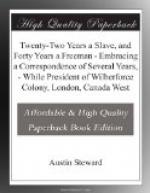CHAPTER XVI.
BRITISH EMANCIPATION OF SLAVERY.
As time passed on I found myself progressing in a profitable business. I had paid for my house and lot, and purchased another adjoining, on which I had erected a valuable brick building. The Lord prospered all my undertakings and I felt grateful for my good fortune. I kept all kinds of groceries and grain, which met a ready sale; and now I began to look about me for a partner in life, to share my joys and sorrows, and to assist me on through the tempestuous scenes of a life-long voyage. Such a companion I found in the intelligent and amiable Miss B——, to whom I was married on the eleventh of May, 1825. She was the youngest daughter of a particular friend, who had traveled extensively and was noted for his honesty and intelligence.
About this time, too, “Sam Patch” made his last and fatal leap from a scaffold twenty five feet above the falls of Genesee, which are ninety-six feet in height. From thence he plunged into the foaming river to rise no more in life. The following spring the body of the foolish man was found and buried, after having lain several months in the turbulent waters of the Genesee.
This year was also rendered memorable by the efficient labors of Professor Finney, through whose faithful preaching of the gospel, many were brought to a saving knowledge of the truth.
The “Emancipation Act” had now been passed, and the happy time for it to take effect was drawing nigh. Slavery could no longer exist in the Empire State nor receive the protection of her laws. Would to God it had so continued to be what it professed—the refuge of the bondman and the home of the free. But alas! Now the flying fugitive from Slavery finds no security within her borders; he must flee onward, to the dominion of Queen Victoria, ere he rests, lest the exaction of the odious “Fugitive Slave Law” return him to the house of bondage.
But the Emancipation Bill had been passed, and the colored people felt it to be a time fit for rejoicing. They met in different places and determined to evince their gratitude by a general celebration. In Rochester they convened in large numbers, and resolved to celebrate the glorious day of freedom at Johnson’s Square, on the fifth day of July. This arrangement was made so as not to interfere with the white population who were everywhere celebrating the day of their independence—“the Glorious Fourth,”—for amid the general and joyous shout of liberty, prejudice had sneeringly raised the finger of scorn at the poor African, whose iron bands were loosed, not only from English oppression, but the more cruel and oppressive power of Slavery.
They met according to previous appointment, Mr. A. H——, having been chosen president, Mr. H. E——, marshal, and Mr. H. D——, reader of the “Act of Emancipation,” and “The Declaration of Independence.” A large audience of both white and colored people assembled, and the day which had been ushered in by the booming cannon, passed by in the joyous realization that we were indeed free men. To the music of the band the large procession marched from the square to the hotel, where ample provision was made for dinner, after listening to the following oration, which I had been requested to deliver.




